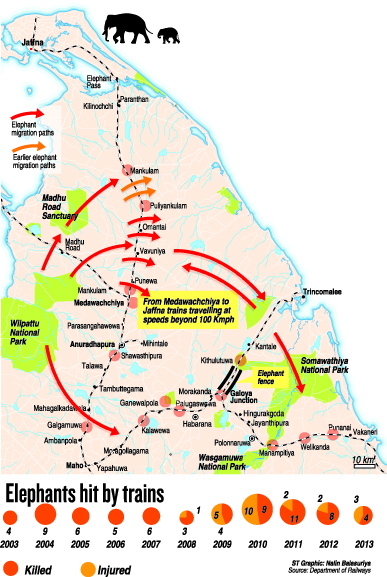News
Infrared cameras soon on trains to prevent elephant deaths
New thermal cameras are to be installed on trains to detect elephants 1km away and prevent collisions, and the Railways Department is taking cognisance of driver suggestions during a pilot project to have an effective system running next year.
The resumption of train services to the north has increased the risks of collision with elephants, said Locomotive Operating Engineers’ Union General Secretary K.A.U Konthesingha.
Elephants roam near the northern line in areas where they had not been previously observed.
“When the services were operating in the 1980s the elephants had been crossing the track between the Puliyankulam and Murukandai stations but now elephants have been found roaming all over the northern line from the Madawachchiya area onwards,” Mr. Konthesingha said.
The presence of elephants was causing delays on the northern line even though trains were now able to exceed a speed of 100kph on the new track.
Mr. Konthesingha said engine drivers had managed so far to avoid accidents even though there were six to seven incidents every week of elephants crossing the northern line track while trains were approaching.
Drivers had found that some elephants hesitated to move away from the tracks even when the horn was tooted.
Apart from the threat of injury or death to elephants, collisions could derail a train travelling at high speed, Mr. Konthesingha said.
Although a joint programme by the Railways and Wildlife Departments had caused a Wildlife Department official to map elephant paths that cross the tracks this was not of much use when train drivers could not see elephants in the dark through the small windscreens of locomotives.
He said elephants were crossing railway tracks even in areas such as Moragollagamuwa to Kantale that had electric fences to prevent elephant traffic.
Mr. Konthesingha said the Railways Department’s pilot programme of attaching thermal cameras to the tops of trains to detect elephants at a distance of 1km had to be improved to be truly effective.
While the camera detected and highlighted approaching heat sources it was difficult to identify the detected image as an elephant.
Also, the camera focus changed when the train was taking a bend and therefore adjustments needed to be made.
The Additional General Manager of Railway Operations, H.T. Nalaka Bandara, said drivers had been instructed to slow down at night in elephant-crossing areas due to poor visibility.
“An engine driver cannot immediately stop the train due to the length and the weight of the train. That’s why the drivers are told to drive at about 15-20 kph in elephant-crossing areas,” he said.
He said the department was experimenting with new ways to minimise the risks to elephants and trains.
“Elephants are hard to spot day or night and neither the Railways nor Wildlife Departments can stop the elephants’ natural need to roam from one forest to another,” he said.
The Wildlife Department had proposed installing infrared camera on trains, and a donation of a Rs. 2 million camera used by a private mobile service company had been made for the pilot programme.
Mr. Bandara said the camera was useful in detecting wild elephants on the track as it detected their body-heat.
He acknowledged the cameras had to be improved to rotate and adjust the lens and that the display needed improvement to feature image recognition that would give the driver a “beeping” warning of specific objects ahead.
The pilot programme had ended and now the Railways Department was planning to call for tenders and purchase cameras with the specific requirements, ensuring that the modifications requested by engine drivers could be made by next year.
The same system could be used to find track damage as well as to record a log of the train by sending the information received to a black box to identify whether drivers were responsible for accidents.
The time and speed of the train would also be recorded.

